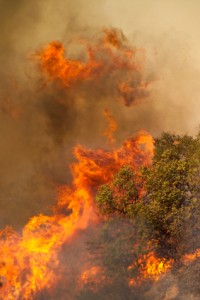
The following information is taken from http://www.usfa.dhs.gov/statistics/national/
A fire can engulf a structure in a matter of minutes. Understanding the basic characteristics of fire and learning the proper safety practices can be the key to surviving a house or building fire.
Before
Install smoke detectors.
Check them once a month and change the batteries at least once a year.
Develop and practice an escape plan. Make sure all family members know what to do in a fire.
- Draw a floor plan with at least two ways of escaping every room. Choose a safe meeting place outside the house.
- Practice alerting other household members. It is a good idea to keep a bell and a flashlight in each bedroom for this purpose.
- Practice safely evacuating the building blindfolded. In a real fire situation, the amount of smoke generated by a fire will most likely make it impossible to see.
- Practice staying low to the ground when escaping.
- Feel all doors before opening them. If the door is hot, get out another way.
- Learn to stop, drop to the ground, and roll if clothes catch fire.
During
Get out as quickly and as safely as possible.
Use the stairs to escape.
When evacuating, stay low to the ground.
If possible, cover mouth with a cloth to avoid inhaling smoke and gases.
Close doors in each room after escaping to delay the spread of the fire.
If in a room with a closed door:
- If smoke is pouring in around the bottom of the door or it feels hot, keep the door closed.
- Open a window to escape or for fresh air while awaiting rescue.
- If there is no smoke at the bottom or top and the door is not hot, then open the door slowly.
- If there is too much smoke or fire in the hall, slam the door shut.
- Call the fire department from a location outside the house.
After
Give first aid where appropriate. Seriously injured or burned victims should be transported to professional medical help immediately.
Stay out of damaged buildings.
Return home only when local fire authorities say it is safe.
Look for structural damage.
Discard food that has been exposed to heat, smoke, or soot.
Contact your insurance agent.
Don't discard damaged goods until after an inventory has been taken. Save receipts for money relating to fire loss.
Post emergency numbers near telephones.
However, be aware that if a fire threatens your home, you should not place the call to your emergency services from inside the home. It is better to get out first and place the call from somewhere else.
Purchase collapsible ladders and practice using them.
Install A-B-C type fire extinguishers in the home and teach family members how to use them.
Do not store combustible materials in closed areas or near a heat source.
Cooking
Keep the stove area clean and clear of combustibles such as bags, boxes, and other appliances. If a fire starts, put a lid over the burning pan or use a fire extinguisher. Be careful because moving a pan can cause the fire to spread. Never pour water on grease fires.
Check electrical wiring
- Replace wiring if frayed or cracked.
- Make sure wiring is not under rugs, over nails, or in high traffic areas. Do not overload outlets or extension cords.
- Outlets should have cover plates and no exposed wiring.
- Only purchase appliances and electrical devices that have a label indicating that they have been inspected by a testing laboratory such as Underwriter's Laboratories (UL) or Factory Mutual (FM).
Contact your local fire department or American Red Cross chapter for more information on fire safety.
Heating Devices
Heating devices such as portable heaters, wood stoves, and fireplaces demand safe operation. Use portable heaters in well-ventilated rooms only. Refuel kerosene heaters outdoors only. Have chimneys and wood stoves cleaned annually. Buy only approved heaters and follow the manufacturers' directions.
Smoke Detectors
Smoke detectors more than double the chance of surviving a fire. Smoke detectors sense abnormal amounts of smoke or invisible combustion gases in the air. They can detect both smoldering and burning fires. At least one smoke detector should be installed on every level of a structure. Test the smoke detectors each month and replace the batteries at least once a year. Purchase smoke detectors labeled by the Underwriter's Laboratories (UL) or Factory Mutual (FM).
The United States has a severe fire problem, more so than is generally perceived. Nationally, there are millions of fires, thousands of deaths, tens of thousands of injuries, and billions of dollars that are lost. In recent news, there was a fire outside of Reno, Nevada that destroyed 29 homes and forced thousands to evacuate from their homes. The blaze burned nearly 3,200 acres with some reported flames of 40 feet high. This is just another reminder of the importance of emergency fire safety. For more information visit www.fema.gov

